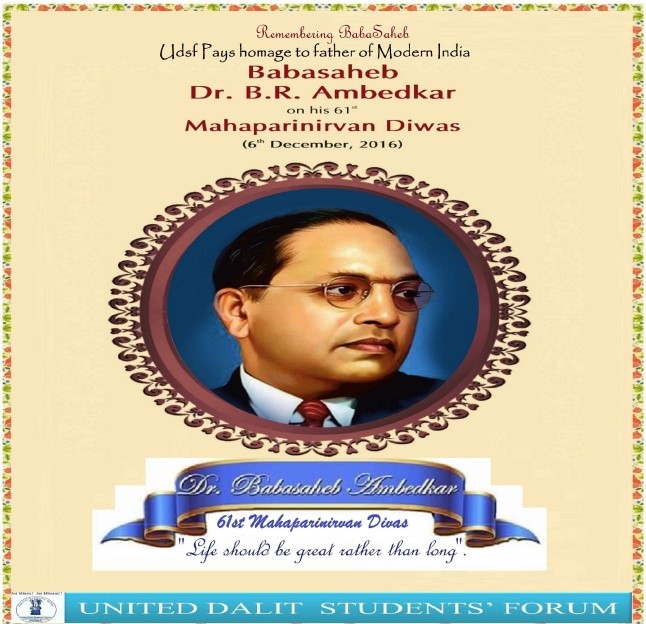Nikhil SanjayRekha Adsule
 There has been a great hustle and bustle owing to the technique of “Vipassana” which is in full vigour since 1972 in India. One Satyanarayan Goenka is proclaimed to have reintroduced it again in the land where Buddhism originated and thus unveiling a new revolution. The prevalence of Vipassana is garnering a huge fan following among the so-called neo middle class Dalits who after slight change in class have ingrained in themselves a new consciousness which regards themselves first as Buddhists and later (if they feel) as feeble Ambedkarites with a sense of hesitancy as can be sensed when they appear embarrassed to say Jai Bheem!
There has been a great hustle and bustle owing to the technique of “Vipassana” which is in full vigour since 1972 in India. One Satyanarayan Goenka is proclaimed to have reintroduced it again in the land where Buddhism originated and thus unveiling a new revolution. The prevalence of Vipassana is garnering a huge fan following among the so-called neo middle class Dalits who after slight change in class have ingrained in themselves a new consciousness which regards themselves first as Buddhists and later (if they feel) as feeble Ambedkarites with a sense of hesitancy as can be sensed when they appear embarrassed to say Jai Bheem!
Vipassana is in the primary stage a 10-day course which stresses on “Seeing yourself in a new way” via concentrating your senses on the metaphysics of body and associated changes in them. To analyse it critically in sense of an Ambedkarite framework it needs to be thoroughly interrogated along the lines done by senior Ambedkarites like Yashwant Manohar, Raja Dhale and others.
It must be remembered that we are first Ambedkarites and then Buddhists as it was Dr Ambedkar who chose to convert into Buddhism (He was thinking of Sikhism too and even in 1928 spoke of conversion to Islam -Gail Omvedt). So, we being Buddhists is via the path that Ambedkar adopted and what Ambedkar might expect from us. Buddhism today is hijacked via Vaishnavite tendencies as noted by Suvira Jaiswal in her “The making of Brahmanic hegemony” and even deified after Mahayanism. Babasaheb Ambedkar clearly explained this in “Buddha and his Dhamma” which rescues Buddhism from Brahmanical forces and sets before us a pragmatic, rational and scientific Buddha!
Vipassana, on the other hand, hacks Babsaheb’s purpose and gives it a personalised, narrow and mystic attire and thus making the person neglect the practical struggles against gender, caste, and class. By itself, it furthers practicing biases by segregation of sexes, Gandhian idea of untouchability as the only evidence of caste and catering especially to neo middle class by appealing to them repeatedly during evening discourses to donate money and other things as a form of “paramita” as told by Buddha. His discourses that used mythological examples sometimes helps assimilate brahminical traits intangibly and cunningly in the subconscious of Ambedkarites and that of the populace at large.
It dents the struggle and acts as a deterrent by puncturing the struggle for true liberation and freedom by its methodological approach to erode the radicalism, pragmatism and the principles on which the fight for “Humanity” is based. Thus there is a need to revisit Ambedkar’s texts again and again in this age of neopeshwai and gauge how the brahmanical forces impose on Ambedkarite movements, attempting to take away the zeal and revolutionary characteristics. There is a need to reflect upon the above points as we are not here for personal salvation but for the salvation of the society at large which has been rightly pointed out by writers like Yashwant Manohar in his “Dr Babasaheb Ambedkaranni vipassana ka nakarli” (Dr Babasaheb Ambedkar rejected vipassana) and Raja Dhale in his ” Vipassana ek thotand”. They urge us to focus on the principles of rationality, scientific attitude and humanity in the creation of a society which poet Dhasal dreams of in his poem “Manasane” i.e a Fraternity based one!
Jaibheem!
Nikhil SanjayRekha Adsule is an electrical engineer and is currently pursiing LLB from Savitribai Phule Pune University. He is an Ambedkarite who dreams of creating a Begumpure of genderless, casteless, classless society.










